Murine cytomegalovirus inhibits interferon gamma-induced antigen presentation to CD4 T cells by macrophages via regulation of expression of major histocompatibility complex class II-associated genes
- PMID: 9529320
- PMCID: PMC2212213
- DOI: 10.1084/jem.187.7.1037
Murine cytomegalovirus inhibits interferon gamma-induced antigen presentation to CD4 T cells by macrophages via regulation of expression of major histocompatibility complex class II-associated genes
Abstract
CD4 T cells and interferon gamma (IFN-gamma) are required for clearance of murine cytomegalovirus (MCMV) infection from the salivary gland in a process taking weeks to months. To explain the inefficiency of salivary gland clearance we hypothesized that MCMV interferes with IFN-gamma induced antigen presentation to CD4 T cells. MCMV infection inhibited IFN-gamma-induced presentation of major histocompatibility complex (MHC) class II associated peptide antigen by differentiated bone marrow macrophages (BMMphis) to a T cell hybridoma via impairment of MHC class II cell surface expression. This effect was independent of IFN-alpha/beta induction by MCMV infection, and required direct infection of the BMMphis with live virus. Inhibition of MHC class II cell surface expression was associated with a six- to eightfold reduction in IFN-gamma induced IAb mRNA levels, and comparable decreases in IFN-gamma induced expression of invariant chain (Ii), H-2Ma, and H-2Mb mRNAs. Steady state levels of several constitutive host mRNAs, including beta-actin, cyclophilin, and CD45 were not significantly decreased by MCMV infection, ruling out a general effect of MCMV infection on mRNA levels. MCMV effects were specific to certain MHC genes since IFN-gamma-induced transporter associated with antigen presentation (TAP)2 mRNA levels were minimally altered in infected cells. Analysis of early upstream events in the IFN-gamma signaling pathway revealed that MCMV did not affect activation and nuclear translocation of STAT1alpha, and had minor effects on the early induction of IRF-1 mRNA and protein. We conclude that MCMV infection interferes with IFN-gamma-mediated induction of specific MHC genes and the Ii at a stage subsequent to STAT1alpha activation and nuclear translocation. This impairs antigen presentation to CD4 T cells, and may contribute to the capacity of MCMV to spread and persist within the infected host.
Figures
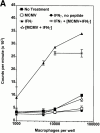

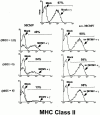
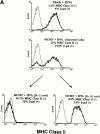



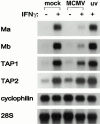
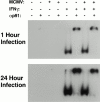
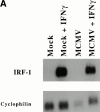

Similar articles
-
Murine cytomegalovirus infection inhibits IFN gamma-induced MHC class II expression on macrophages: the role of type I interferon.Virology. 1998 Feb 15;241(2):331-44. doi: 10.1006/viro.1997.8969. Virology. 1998. PMID: 9499808
-
Restoration of cytomegalovirus antigen presentation by gamma interferon combats viral escape.J Virol. 1994 Jan;68(1):289-97. doi: 10.1128/JVI.68.1.289-297.1994. J Virol. 1994. PMID: 8254740 Free PMC article.
-
TGF-beta1 and IFN-gamma cross-regulate antigen presentation to CD4 T cells by macrophages.J Leukoc Biol. 2002 Jul;72(1):163-6. J Leukoc Biol. 2002. PMID: 12101276
-
Regulation of antigen presentation by Mycobacterium tuberculosis: a role for Toll-like receptors.Nat Rev Microbiol. 2010 Apr;8(4):296-307. doi: 10.1038/nrmicro2321. Nat Rev Microbiol. 2010. PMID: 20234378 Free PMC article. Review.
-
Major histocompatibility complex class II in the tumor microenvironment: functions of nonprofessional antigen-presenting cells.Curr Opin Immunol. 2023 Aug;83:102330. doi: 10.1016/j.coi.2023.102330. Epub 2023 Apr 30. Curr Opin Immunol. 2023. PMID: 37130456 Free PMC article. Review.
Cited by
-
Macrophages escape inhibition of major histocompatibility complex class I-dependent antigen presentation by cytomegalovirus.J Virol. 2000 Sep;74(17):7861-8. doi: 10.1128/jvi.74.17.7861-7868.2000. J Virol. 2000. PMID: 10933693 Free PMC article.
-
B cells regulate murine gammaherpesvirus 68 latency.J Virol. 1999 Jun;73(6):4651-61. doi: 10.1128/JVI.73.6.4651-4661.1999. J Virol. 1999. PMID: 10233924 Free PMC article.
-
Biologic consequences of Stat1-independent IFN signaling.Proc Natl Acad Sci U S A. 2001 Jun 5;98(12):6680-5. doi: 10.1073/pnas.111163898. Proc Natl Acad Sci U S A. 2001. PMID: 11390995 Free PMC article.
-
Antiviral T cell response triggers cytomegalovirus hepatitis in mice.J Virol. 2012 Dec;86(23):12879-90. doi: 10.1128/JVI.01752-12. Epub 2012 Sep 19. J Virol. 2012. PMID: 22993151 Free PMC article.
-
Identification of a mouse cytomegalovirus gene selectively targeting CD86 expression on antigen-presenting cells.J Virol. 2004 Dec;78(23):13062-71. doi: 10.1128/JVI.78.23.13062-13071.2004. J Virol. 2004. PMID: 15542658 Free PMC article.
References
-
- Pavic I, Polic B, Crnkovic I, Lucin P, Jonjic S, Koszinowski UH. Participation of endogenous tumour necrosis factor-alpha in host resistance to cytomegalovirus infection. J Gen Virol. 1993;74:2215–2223. - PubMed
-
- Orange JS, Biron CA. Characterization of early IL-12, IFN-alpha/beta, and TNF effects on antiviral state and NK cell responses during murine cytomegalovirus infection. J Immunol. 1996;156:4746–4756. - PubMed
Publication types
MeSH terms
Substances
Grants and funding
LinkOut - more resources
Full Text Sources
Research Materials
Miscellaneous

